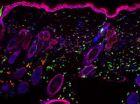(Press-News.org) In rare cases, patients with allergies to metals develop persistent skin rashes after metal devices are implanted near the skin. New research suggests these patients may be at increased risk of an unusual and aggressive form of skin cancer.
Metal alloys help make orthopedic implants stronger and more durable. But people with sensitivity to these metals, which include nickel, cobalt and chromium, can develop chronic inflammation that promotes the development of skin cancers, report researchers at Washington University School of Medicine and Barnes-Jewish Hospital in St. Louis.
The team's findings were published online Oct. 8 in the Journal of Clinical Investigation.
The researchers were alerted to the connection by a patient who had surgery at another hospital to have a metal rod implanted to repair a fractured ankle. After the surgery, the patient developed a skin rash on her ankle, near the location of the implant.
The patient turned out to be allergic to nickel in the implant, which led surgeons at the other hospital to remove it. But the rash persisted, and a few years later, a rare form of skin cancer known as Marjolin's ulcer developed at the surgical site. The cancer, which had become painful and ulcerated, was diagnosed and removed by physicians at Barnes-Jewish Hospital.
The researchers showed in mouse models that chronic skin inflammation caused by continuous skin contact with allergens contributes to tumor development. The finding suggests that patients with metal implants near the skin may need to be monitored for this type of inflammation, according to the researchers. The results likely also will lead to debate and further research on whether physicians should test for metal sensitivity in patients preparing for surgery to get these types of implants.
Chronic inflammation from metal implants can cause joint pain and swelling and contribute to joint failure. And when these implants are placed near the skin, fewer than 5 percent of patients develop an inflammatory rash related to the implant.
The patient's diagnosis with Marjolin's ulcer, an invasive and potentially deadly squamous cell cancer, surprised physicians. The patient was under 50 years old, and Marjolin's ulcer is extremely rare in people who are young and otherwise healthy. This type of cancer most often is identified in patients with a previous history of skin cancers, but this patient had never had skin cancer.
To investigate whether inflammation from the implant contributed to the tumor, the researchers studied mouse models of contact allergy.
"A contact allergy is a different kind of reaction from allergies to pollen, pet dander or food," said senior author Wayne M. Yokoyama, MD, a Howard Hughes Medical Institute investigator at the School of Medicine. "A contact allergy usually develops when an allergen touches the skin or is close to it. Skin rash in response to nickel and poison ivy are two common examples of contact allergies."
The researchers showed that contact allergy brings inflammatory cells and molecules to the site of the allergic reaction. If the contact allergen remains a long time – as was the case with the patient's implant – different inflammatory cells and molecules become active at the site of the reaction. The new mix of cells and molecules promotes the development of skin tumors.
"This model supported cancer development so strongly that some mice developed invasive squamous cell skin cancers similar to the patient's tumor," said lead author Shadmehr Demehri, MD, PhD, a dermatologist and postdoctoral fellow.
When the researchers examined the cells and molecules involved in chronic contact allergy in mice, they identified several that already had been linked to tumor development. Some of these cells and molecules also were present in biopsy samples from the patient's ankle. The scientists are working to identify which inflammatory cells and molecules are most supportive of cancer formation.
"If you're allergic to something, the first thing to do is to avoid it, but the patient couldn't," said Yokoyama, the Sam and Audrey Loew Levin Professor of Medicine. "Some nickel had likely seeped from it into her tissue and was still present in her skin even after the implant was removed. It's as if a patient allergic to poison ivy kept putting poison ivy on the skin."
To prevent such adverse events, the researchers suggested that the potential for allergic reactions to metal implants be assessed in patients who have had the implants and in patients preparing to receive them.
"Allergen-free versions of some implants are available," Demehri said. "These versions may cost more or be less durable, but for some patients with sensitivity to metals, they may be the best option."
Similar to metal implants, some dental restoration materials and tattoo inks contain substances associated with allergic reactions and cancers on the skin or in the mouth. Those clinical observations also could be explained by the new findings. The researchers suggested that the potential for these other allergens to promote skin cancer needs to be examined further.
INFORMATION:
This research and the investigators who conducted it were supported by the National Institutes of Health (NIH) (S10-RR0227552), the Howard Hughes Medical Institute, the American Skin Association and the Dermatology Foundation.
Demehri S, Cunningham TJ, Hurst EA, Schaffer A, Sheinbein DM, Yokoyama WM. Chronic allergic contact dermatitis promotes skin cancer. The Journal of Clinical Investigations, online Oct. 8, 2014.
Washington University School of Medicine's 2,100 employed and volunteer faculty physicians also are the medical staff of Barnes-Jewish and St. Louis Children's hospitals. The School of Medicine is one of the leading medical research, teaching and patient-care institutions in the nation, currently ranked sixth in the nation by U.S. News & World Report. Through its affiliations with Barnes-Jewish and St. Louis Children's hospitals, the School of Medicine is linked to BJC HealthCare.
VIDEO:
Dr. Myron M. Levine, Director of the Center for Vaccine Development at the University of Maryland School of Medicine describes the Ebola vaccine testing taking place in Mali, West Africa.
Click here for more information.
Professor Myron M. Levine, MD, Director of the Center for Vaccine Development (CVD) at the University of Maryland School of Medicine (UM SOM), and UM SOM Dean E. Albert Reece MD, PhD, MBA, announced today that the CVD, in conjunction with its sister institution, ...
People with autism spectrum disorder often experience a period of accelerated brain growth after birth. No one knows why, or whether the change is linked to any specific behavioral changes.
A new study by UCLA researchers demonstrates how, in pregnant mice, inflammation, a first line defense of the immune system, can trigger an excessive division of neural stem cells that can cause "overgrowth" in the offspring's brain.
The paper appears Oct. 9 in the online edition of the journal Stem Cell Reports.
"We have now shown that one way maternal inflammation could result ...
Washington, DC—A new study in human placenta provides the strongest evidence to date that Endocrine Disrupting Chemicals (EDCs) can interfere with thyroid hormone action in pregnant women. The implication is that flame retardant chemicals called polychlorinated biphenyls (PCBs) can infiltrate the placenta during pregnancy and affect thyroid hormone activity at the cellular level, according to a new study published in the Endocrine Society's Journal of Clinical Endocrinology & Metabolism (JCEM).
PCBs were used in transformers and other electrical equipment, paints, ...
Washington, DC—Exposure to cold temperatures can convert white fat tissue from the thighs and belly to beige fat that burns calories for heat, but this biological response is hampered in obese people, according to a new study published in the Endocrine Society's Journal of Clinical Endocrinology & Metabolism.
Known as brown adipose tissue (BAT), brown fat is a particular kind of fat tissue that burns energy and glucose to generate heat. Babies and small animals rely on brown fat to stay warm. Brown fat's energy expenditure helps to prevent obesity in rodents.
While ...
Researchers from the National Cancer Institute report that decaffeinated coffee drinking may benefit liver health. Results of the study published in Hepatology, a journal of the American Association for the Study of Liver Diseases, show that higher coffee consumption, regardless of caffeine content, was linked to lower levels of abnormal liver enzymes. This suggests that chemical compounds in coffee other than caffeine may help protect the liver.
Coffee consumption is highly prevalent with more than half of all Americans over 18 drinking on average three cups each day ...
CAMBRIDGE, Mass--A long-sought goal of creating particles that can emit a colorful fluorescent glow in a biological environment, and that could be precisely manipulated into position within living cells, has been achieved by a team of researchers at MIT and several other institutions. The finding is reported this week in the journal Nature Communications.
The new technology could make it possible to track the position of the nanoparticles as they move within the body or inside a cell. At the same time, the nanoparticles could be manipulated precisely by applying a magnetic ...
(SALT LAKE CITY)—A University of Utah-led study using X-rays and neutron beams has revealed the inner workings of a master switch that regulates basic cellular functions, but that also, when mutated, contributes to cancer, cardiovascular disease and other deadly disorders.
Learning more about how the Protein Kinase A (PKA) switch works will help researchers to understand cellular function and disease, according to Donald K. Blumenthal, Ph.D., associate professor of pharmacology and toxicology at the University of Utah (U of U) College of Pharmacy who led the study. ...
A supernova is the cataclysmic death of a star, but it seems its remnants shine on. Astronomers have found a pulsating, dead star beaming with the energy of about 10 million suns.
This is the brightest pulsar -- a dense stellar remnant leftover from a supernova -- ever recorded, and was seen using NASA's Nuclear Spectroscopic Telescope Array, or NuSTAR.
Lawrence Livermore LLNL researchers were involved in the design and testing of the NuSTAR X-ray optics.
"You might think of this pulsar as the 'Mighty Mouse' of stellar remnants," said Fiona Harrison, the NuSTAR principal ...
NASA's Aqua satellite passed over Super Typhoon Vongfong as it tracked through the Philippine Sea on Oct. 9. Instrument aboard Aqua captured visible and infrared images of the now Category 4 Super Typhoon.
Two instruments aboard NASA's Aqua satellite provided visible and infrared data on the Super Typhoon: The Moderate Resolution Imaging Spectroradiometer or MODIS and the Atmospheric Infrared Sounder or AIRS instrument, respectively. MODIS captured a visible image of Super Typhoon Vongfong on Oct. 9 at 04:25 UTC (12:25 a.m. EDT) that showed two concentric eyewalls with ...
Neurodevelopmental disorders such as Down syndrome and autism-spectrum disorder can have profound, lifelong effects on learning and memory, but relatively little is known about the molecular pathways affected by these diseases. A study published by Cell Press October 9th in the American Journal of Human Genetics shows that neurodevelopmental disorders caused by distinct genetic mutations produce similar molecular effects in cells, suggesting that a one-size-fits-all therapeutic approach could be effective for conditions ranging from seizures to attention-deficit hyperactivity ...


